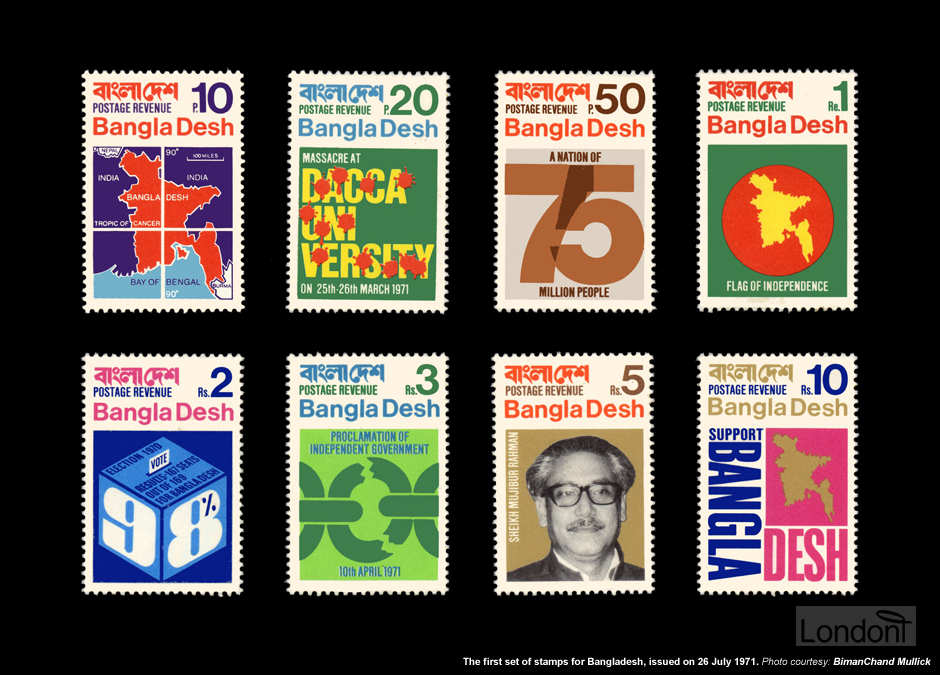
First postage stamps of Bangladesh
Last updated: 26 November 2019 From the section 1971 Muktijuddho
Using stamps to create global awareness
During the war, the Mujibnagar Shorkar established field post offices, took control over existing post offices in the liberated areas, and put the postal department under the Ministry of Transport and Communication. From April until July 1971 they used stamps stolen by a philatelic officer of Dhaka GPO. The officer escaped with the old commemorative stamps that were in stock of Dhaka Treasury, and handed them over to the Bangladesh Authority for overprinting.
In May 1971 a decision was taken to issue Bangladesh's own stamps following a visit of British MP John Stonehouse to Mujibnagar Government. Stonehouse was a trustee of Bangladesh Trust Fund along with Justice Abu Sayeed Chowdhury. He came to Kolkata on behalf of 'War on Want', a charity which openly campaigned for the liberation of Bangladesh. In his book "Death of an Idealist" written four years after the Bangladesh Liberation War, John Stonehouse wrote that it was him who came up the idea for the creation of Bangladesh stamps and that Prime Minister Tajuddin Ahmad and his colleagues gave their consent. According to General Secretary of Philatelist Association of Bangladesh (PAB), A. T. M. Anowarul Haque Quadir, a committee comprising of Prime Minister Tajuddin Ahmad and prominent painters Qamrul Hasan and Nitin Kundu amongst others felt that the stamps would be a great way of spread awareness globally of the events in Bangladesh and thus gave their blessing. However, BimanChand Mullick, who designed the stamps, said that he had never heard about any 'committee'. Nevertheless, John Stonehouse took on the responsibility of producing the stamps after the gaining Mujibnagar Shorkar's blessing. John Stonehouse wrote in his autobiography, 'Death of an Idealist':
It became clear that the situation would get far worse and the war of liberation could take years to fight. I decided to step up the campaign in Britain and to try to establish such a powerful lobby for Bangla Desh that even Governments would have to listen. I suggested to Tajuddin and Mansoor Ali the Minister of Finance who was also present that Bangla Desh should issue postage stamps which could be used for mail from the liberated areas and which would also be excellent propaganda to establish the fact of the existence of Bangla Desh. They consulted colleagues and told me the next day that the idea had been approved by the Government. They asked me to organise the printing and publishing of the stamps and gave me an official authority stamped by the Government of Mujibnagar, which was the name of the mythical and ever-moving capital of the exile administration.
When I returned to London, I contacted Biman Mullick the Indian artist, who is a Bengali from West Bengal, and asked him to design a series of six stamps. Mullick had designed the Gandhi stamp for the GPO when I was Postmaster General and I knew he had the talent.
Extract from "Death of an Idealist" (1975) by John Stonehouse (pages 107-108)
Young Indian-Bengali graphic designer works for free and creates 8 historic stamps in 3 weeks
When he returned to UK, John Stonehouse met with Justice Abu Sayeed Chowdhury of the Bangladesh Mission in UK and introduced him to BimanChand Mullick, a 37-year-old Indian Bengali graphic designer and illustrator born in Howrah near Kolkata but residing in UK. Biman was an award-winning stamp designer who had received international recognition two years earlier after he designed a stamp to commemorate Mahatma Gandhi's birth centenary. In 1969 the General Post Office of United Kingdom released the stamp - making it 'the first British stamp to commemorate an overseas leader and the first to be designed by an overseas artist' '(Ref. GPO Press & Broadcasting Notice No.PB167 dated 7 July 1969). John Stonehouse was the Postmaster General at that time and was aware of BimanChand's contribution.
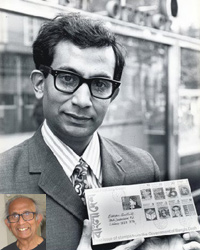
BimanChand Mullick
(Born 17 Dec 1933)
Eminent illustrator, lecturer and author. Born in Howrah, West Bengal, India. Mother Shroddha Devi and father Ajit Kumar Mullick, who was a writer, freedom fighter and close associate of Mahatma Gandhi. 9th out of 11 children (3 girls & 8 boys).
Attended Dharani Dhar Mullick High English School founded by father Ajit Kumar in memory of BimanChand's grandfather Dharani Dhar Mullick (school later renamed to "Madhya Howrah Shikshaloy"). Attended Central Calcutta College (previously called Islamia College and attended by Sheikh Mujibur Rahman, and later renamed to Maulana Azad College) then Scottish Church College, both part of Calcutta University. Edited college magazines and received highest honour in fine art section in two major university festivals. Started composing poetry from early age and was encouraged to provide drawings along with poetry. Joined army briefly but sought discharge as he was not keen.
A resident of London, UK, since 1960. Completed Graphics Design degree (1964) from St. Martin's School of Art, London, UK, whilst a general porter at a teahouse. On completion of degree, travelled to Geneva, Switzerland, to work as Graphics Designer, but returned to London and worked in various advertising companies. Travelled back to India to marry Aparajita in 1966. Designed 'Gandhi Centenary Year 1969' postage stamp for the British Post Office (1969), the first stamp to commemorate an overseas leader and the first designed by an overseas artist. Designed first (8) stamps of Bangladesh in July 1971 for free. Freelance designer and regular visiting lecturer in different educational institutions including the Middlesex University (UK) and Kingston University (UK). Also gave occasional lectures on Indian Art at Manchester University and the Nehru Centre (High Commission of India) London.
Author of books including "Vidyasagar" (West Bengal Government, 1956), "Hanuman Saves the Prince" (Harper Collins: London and Glasgow, 1991), "Durer Kakoli" (Dhaka, 2011). ), "Durer Durga" International paperback edition (2016), Indian hardback edition (2018), "My 1st book of Bengali Amar Prothom Bangla Boi" (2016), and "A Collector's Book of Eight Drawings by Biman Mullick with eight Indian Vegetarian Recipes by Aparajita Mullick" (2019) Jointly authored by wife, Aparajita Mullick. Worked in many multi-script typography (e.g. Bengali, Punjabi, Urdu) and multi-lingual (e.g. French, Spanish, Somali, Turkish) projects. Became a fellow of Royal Society of Arts in the late 1960s but later renounced it due to high annual fee. Also became member of Chartered Society of Designer but renounced this also due to financial reasons. However, has remained a fellow of International Society of Typographic Designers. As an artist contributed to projects by BBC, Oxford University Press, Cambridge University Press and many more. Book 'Myths and Legends of India' (1970) by Paul Hamlyn contains over 100 full-colour drawings by him. Several national and international art galleries and museums have collected his work including the Victoria and Albert Museum, the National Postal Museum (London, UK), Wellcome Collection(London, UK), National Postal Museum (New Delhi, India), the Lahti International Poster Museum (Finland). Work reviewed in international journals including "IDEA" 232 International Advertising Art. Japan 1992, Novum (Gebrauchsgraphic) Germany, Design Magazine 1972, Journal of Design Council, London, Designer (Journal of the Chartered Society of Designers), Typographic 7 (Journal of the International Society of Typographic Designers), Design Journal 46, Korea March 1992. Work exhibited in many prominent national and international exhibitions. Participated in TV and radio programmes. Interviewed and featured in many TV documentaries including BBC, CNN, ITV, Central TV, Zee TV, and Duradarshan.
In 1988 honoured by World Health Organization (WHO), along with US President Jimmy Carter and Cuban President Fidel Castro, for helping to create a pollution-free world. In 2006, jogged 26.2 miles (42.2 km) long London marathon at the age of 72. Received 'Friends of Liberation War Honour' from Government of Bangladesh on 27 March 2012. An avid music lover and active contributor to Ragamala Graphics (painting music). Passion for collecting Bengali dictionaries, listening to Indian and European classical music – die-hard Rabindra Sangeet fan, has collected around 2,000 songs – architecture, jogging and travelling (has travelled 5 continents). Does not have "firm belief in so-called organised religion, but sit on the fence and myself an agnostic". Has a website, YouTube channel, and Facebook page.
In the late 1950s in Calcutta I worked at Pearl Chemical Industries, a pharmaceutical firm founded by my uncle Shashanka Shekher Mullick. My particular responsibility was to look after its publicity design and advertising. The job gave me a first hand experience of how the advertising world works. I was attracted by its glamorous aspect and wanted to have a career in advertising. I applied and got an admission on a course in advertising in a college in Dagenham, Essex, UK. My letter of admission was useful in obtaining a passport to travel abroad. At that time as a commonwealth citizen I did not need a visa to enter UK.
In 1960 I jumped on a boat at Cochin in South India with £5 in my pocket and headed for London. After three weeks on the sea I arrived in London. I came to my senses; I did not take the admission in advertising but joined St. Martin's School of Art for a four-year full-time course in Advertising Design. At the same time I also took a full-time job as a general porter at Lyons Corner House a well-known restaurant in London. Both of them I continued till 1964. At the end of the course 27 students appeared for the final examination, 3 passed and with my surprise I became the 1st and got the National Diploma in Design. I was surprised because I never did well in examinations. As a part of the course one had to undertake a research project. Most students were sensible and practical, chose a simple topic, took out some relevant books from the library and produced a thesis. Being an impractical person I took an over ambitious project on Palaeolithic art, not only read whatever I could put my hands on, but also went to visit Altamira in Spain and Lascaux in France to see the original cave paintings. I am glad that I did. Now the caves are closed to the public. Anyway, my thesis on the "Graphic Potentiality of Palaeolithic Art" was highly praised.
During this time as a freelancer I also took part in broadcasting in the Bengali section of BBC world service and continued contributing Bengali prose and poems to Bengali literary magazines published from Calcutta (now known as Kolkata) in West Bengal, India.
In 1964, after finishing my course at St Martin’s I gave-up my job as a porter and hitchhiked to Geneva and got my first job as a Graphic Designer. In Geneva I was told by my colleagues, "We don’t use Universe we use Helvetica". To me it was a new experience. I came across the Swiss attitude to typography, which left a great impression on me.
...In 1969 I was invited to participate in a competition among a selected group of 7 designers to submit ideas for a postage stamp to celebrate Gandhi Centenary Year. I believe in doing my best but never liked the idea of competition. My design idea was accepted. The stamp became "the first British postage stamp to honour a foreign dignitary and the first British postage stamp designed by an 'overseas' artist".
The stamp received several awards, one of them for being the best Gandhi stamp issued by any country. It was chosen from 75 stamps issued by 35 countries. The London Times regarded the stamp as "one of the 20 best British stamp of all-times", The Hindu, a well-known Indian newspaper called it, "a philatelic marvel". A London stamp dealer told me, it was “rubbish”. The stamp dealer did not know that I was the designer. Gandhiji maintained an extremely simple life style. I tried to achieve stark simplicity in this stamp design.
BimanChand Mullick on his early career and designing the Gandhi Centenary Stamp [information received via email]
BimanChand had seen the daily coverage on TV of the "inhumane atrocities" that was being carried out on the Bangladesh public. So, when the opportunity came to contribute and aid the suffering people he agreed instantly.
On 29 April 1971 BimanChand returned home exhausted from his teaching duties. His wife Aparajita informed him that John Stonehouse had rung but did not leave his contact number. He'd call back again.
John rang again after few hours. They set up a meeting at Houses of Parliament.
...On 29 April 1971, unexpectedly, I received a phone call from John Stonehouse who introduced himself as the former Postmaster general of Great Britain also a "representative" of Bangla Desh. He was authorised by Mr Tajuddin Ahmad and his cabinet to supervise Postage stamp project that is why he called himself, "a representative of Bangladesh". I also referred him as a "representative of Bangla Desh". I think it would be better to explain. Otherwise confusion regarding this "Representative" will remain.
BimanChand Mullick on how he met John Stonehouse [information received via email]
John Stonehouse said to me "Do you know the situation in Bangladesh?"
I replied "Yes I do".
"OK, they want to create stamps on behalf of Bangladesh - will you design them?"
I instantly replied "Yes!" without any hesitation. Then John Stonehouse told me to meet him tomorrow, but I told him I couldn't attend tomorrow as I was teaching college students but could meet him the day after.
We meet that day and spoke for a while. I asked him for a design brief, which is a usual practise for a designer to a client to ask for a design brief. He replied, "There is no brief. We don't have much time. We would like to give you the full responsibility for the project." It was a huge responsibility.
BimanChand wanted to tell the story of Bangladesh and was aware of the responsibility and task that lay ahead. Eight stamps would be sufficient for him to convey the story and also look nice and presentable on First Day Cover (FDC). He worked tirelessly to complete the design as soon as possible. Amazingly, in addition to teaching five days a week, travelling 500 miles and completing other freelance work, BimanChand completed the design for 8 stamps for the Bangladesh government within just three weeks. Bold, vivid and dramatic, the designs powerfully captured the bloody revolution that was only few weeks old.
BimanChand Mullick: "Donald Chesworth delivered design copy to Mujibnagar Government for approval, and I never met a Dr. Enamul Haque"
It is commonly cited that John Stonehouse had met Dr. Enamul Haque, then President of Bangladesh Peoples' Cultural Society, via Justice Abu Sayeed Chowdhury and Stonehouse introduced him to BimanChand Mullick. It is also alleged that by mid-June Dr. Enamul Haque sent these to the Mujibnagar Shorkar for approval. Three weeks later, on 8 July 1971, the Principle aide to PM Tajuddin Ahmad, 'Rahmat Ali' - a pen name used by Barrister Amirul Islam to protect his real identity - gave consent on behalf of Bangladesh's government.
With regard to the Philatelic [or stamps], the designs have been approved. If you have other designs in hand please go ahead and send them for approval. There is no harm in having more.
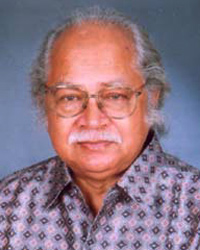
Enamul Haque
(Born 9 October 1936)
Historian, archaeologist, museologist (founder Director General of Bangladesh National Museum) and poet. Born in Bogra.
Completed bachelor's and master's degree from Dhaka University, PhD in South Asian Art from Oxford University and Post-Graduate Diploma-in-Museology from London. First individual in sub-continent to receive a degree in the field of museology.
Joined Dhaka Museum in 1962 and retired from Bangladesh National Museum in 1991. During his tenure, Ahsan Manzil renovated. Elected honorary international councillor of Asia Society of New York (1986 - 92), awarded "Ramaprasad Chanda Centenary Medal" by Asiatic Society of Calcutta (1993) and Bangladesh Shishu Academy Agrani Bank Literary Award (1986). President of the International Council of Museums Asia-Pacific Organisation (1983 - 86). Professor of National Culture and Heritage in the Independent University, Bangladesh. President of International Centre for Study of Bengal Art (ICSBA).
Collected Nakshi Kantha (traditional hand-embroidered quilts) for Nimtoli Museum as art pieces. Written many books focusing on Bangladesh's history and culture and produced several dance-dramas also including 'Shurjomukhi Nodi'. Organised 9th Biannual International Congress on Bengal Art, held in Dhaka.
However, this is false according to BimanChand Mullick. He never met Dr. Enamul Haque nor did Dr. Haque or BimanChand Mullick himself deliver the design to Mujibnagar Shorkar for approval. That honour fell to Donald Chesworth.
BimanChand had designed the rough sketches of the eight stamps and was asked by John Stonehouse to travel to Kolkata and show the stamps to Mujibnagar Shorkar himself. BimanChand accepted the request. However, Stonehouse later phoned him and told him that Donald Chesworth - then a representative of Oxfam who was personally known to Stonehouse - was already going to Kolkata, who will take the designs to show to the Mujibnagar Government. Tajuddin Ahmad and the others approved of the design and BimanChand was given the permission to continue with the final design.
It was an emergency situation. [Under normal condition] If you were to ask me to design something, I'd say OK and design something for you. But I'd also give you one or two alternative design. But this was an emergency situation and there was no time for alternative designs. Each stamp was designed one after another.
-
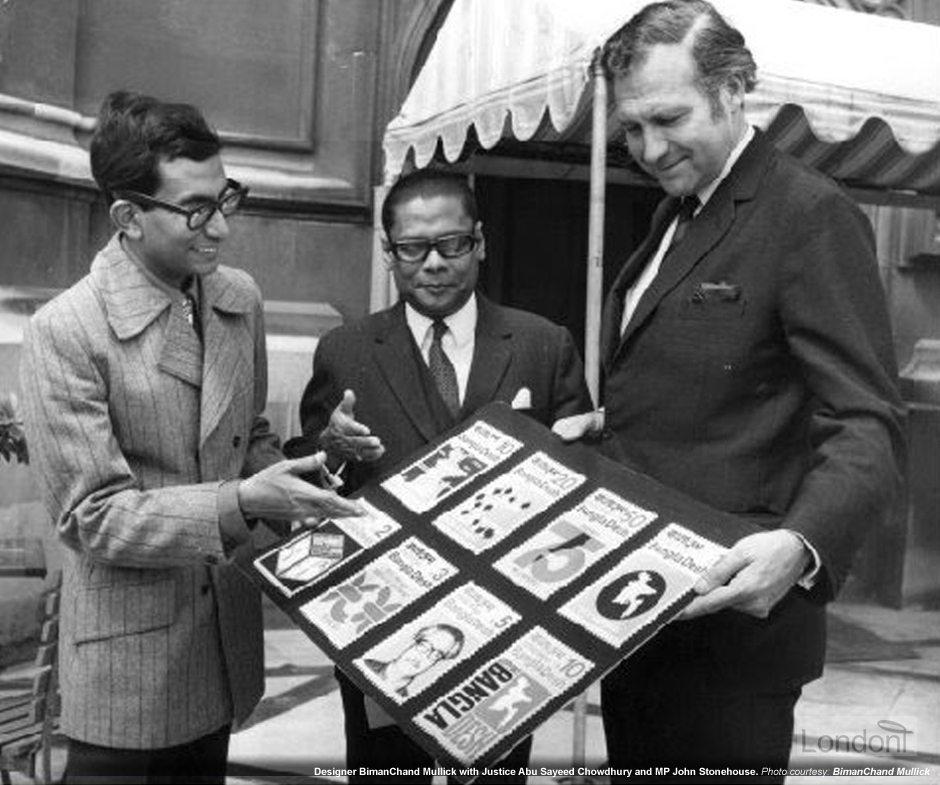
Three weeks after he was assigned with the mammoth task, BimanChand Mullick had completed the design for the 8 stamps. Each stamp captured an event and told the story which led to the creation of Bangladesh. Question such as why the people were fighting, on whose behalf they were fighting, what they were fighting for, all these were aptly answered via the 8 stamps.
The total cost for all the stamps were just over £1 GBP.
The first eight postage stamps of Bangladesh designed by BimanChand Mullick and issued on 29 July 1971 were:
- Map of Bangladesh (10p, p stands for paisa, a hundredth of a rupee) = Symbolises that the people want a country. However, the first thing outsiders would need to know is where this country is located, hence this stamps shows the map of Bangladesh indicating exact 90 degree latitude and longitude – tropic of cancer on the globe. Since this runs almost through the centre of the country both horizontally and vertically, it looks as though BimanChand had split the country into four pieces when this was not his intention.
- Massacre at Dacca University (20p) = The event that led to the uprising (i.e. Operation Searchlight) is symbolised here. As a teacher, BimanChand Mullick could relate to this the most as he could emphasis the heartache he'd felt had his own student been massacred just like the Dhaka University students.
- 75 million People (50p) = People make a country. There were 75 million people in Bangladesh and the unity amongst the people was shown here by merging the '7' and the '5'.
- Flag of Independence (Rs 1) = Every country needs a flag. The flag of an independent nation is shown here. The flag contains the then design for the Jatiyo Potaka with the map, which was later removed to simplify the design.
- Breaking the Chains (Rs 2) = The idea of breaking away from Pakistan and braking the "chain of slavery" is emphasised here.
- 1970 Polls and the Results (Rs 3) = The election result chosen through a democratic process is emphasised here.
- Sheikh Mujibur Rahman (Rs 5) = The man who had inspired the uprising, the leader behind the movement who the people listened to the most was presented here. BimanChand Mullick used a black-and-white photo of Sheikh Mujib which was supplied to him. It is the only stamp which has a photograph. The rest art all 100% artwork.
- Support Bangladesh (Rs 10) = This stamps ask people to support the Bangladesh cause. Bangladesh had nothing then. It needed people's financial and active support that's why a simple, straightforward "Support Bangla Desh" was written on the stamp along with the map of Bangladesh. Hence, it was the most expensive stamp.
Eight stamps looks nice on a First Day Cover (FDC). I had to choose a FDC which is big enough to handle by the postal authority. At the same time it's nice and presentable.
I tried to make it very colourful and dramatic. Either I'm not capable, or I thought it's not the right way of [designing] beautiful, lovely, sweet drawing which most postage stamps are. But they [i.e. the 8 stamps] are not sweet, little, beautiful drawings. They are telling a story.
I did not think that I was a foreigner who was helping Bangladesh out - instead I felt that I was human just helping another human out.
BimanChand Mullick views his contribution as a humanitarian act
Arguably, the event that had personally affected BimanChand Mullick the most was the massacre of Dhaka University students and teachers during 'Operation Searchlight'.
I heard of the killings of Dhaka University students and it shook me up a lot as I emphasised with them wondering if such terrible things ever happened to my students. This also encouraged me to design the stamps.
BimanChand Mullick on how the DU massacre during 'Operation Searchlight' had affected him
'Daktikitey Rokto' poem
To vent his anger at the horror committed by the Pakistani army, BimanChand Mullick wrote the poem "Daktikitey Rokto" (Blood on the Stamps) - a reference to the 20 paisa stamp where the text 'Dacca University' was splatted with red blood - where he labelled the Pakistani army a "bully".
On 31 December 2005, one of Biman's Bangladeshi friends organised a New Year's Eve party. The host asked all his guests to participate in a programme of cultural nature, such as sing a song or recite a poetry etc. Biman was and still is no good in such things, instead he wrote this poem in Bengali on that day and read it at this party.
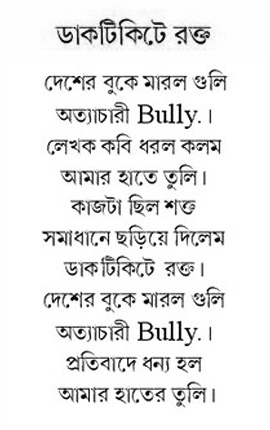
"Daktikitey Rokto" by BimanChand Mullick
Blood on a Postage Stamp / The tyrant, the Bully fired bullets on the bosom of the "Desh" [meaning country but suggesting Bangladesh] / (In protest) writers and poets used their pens / I had a brush in my hand / the task was difficult / as a solution I splattered blood on a Postage Stamp. The tyrant, the Bully fired bullets on the bosom of the "Desh". The paint brush on my hand became blessed by this protest.
After 34 years of Liberation war BimanChand could not forget the atrocities committed on the defenceless and innocent students of Dhaka University. It was the subject of one of his eight postage stamps and this poem is inspired by this stamp.
Publication, and auction in House of Commons
After all formalities were completed, on 26 July 1971 Ambassador Hossain Ali, the head of Bangladesh Mission in Kolkata, announced the news at a press conference held in the Bangladesh Mission. On the same day, over 5,000 miles away, a press conference was also held in the House of Commons of the British Parliament followed by an inaugural ceremony in the Hercourt Room of the House of Commons. The ceremony was attended by John Stonehouse, Peter Shore MP and other distinguished guests, who formally expressed their solidarity with the struggle for independence of Bangladesh.
Three days later, on 29 July 1971, the first stamps of Bangladesh was officially issued.
Neither the Mujinagar Government nor its steering committee sanctioned any funds for designing the stamps or printing them. John Stonehouse passed on this responsibility to ‘E.E Oatway’, a reputed stamp dealer, and a Philatelic investor. He contacted the Format International Security Printers, and finalised the printing of the stamps. Oatway opened the 'Bangladesh Philatelic Agency' at his address in Chobham, Woking (in Surrey, England) and distributed and sold the stamps via the agency. He took the sale proceeds of the stamps, and was responsible for submitting accounts to the Mujibnagar government. Meanwhile, John Stonehouse himself took the responsibility of popularising the stamps in Europe. However, this would only remain as propaganda labels since the stamps didn't have any actual postal value at that time.
The designs he [BimanChand Mullick] produced were excellent, depicting aspects of the Bangla Desh struggle, a map of the country and a photo of Mujibur Rahman. I arranged for FORMAT, the Security Printers, to produce a number of sets sufficient for propaganda sales, for distribution to the various missions and to cover the expenses. FORMAT did an efficient job and the stamps were well received when Mr Justice Abu Sayeed Choudhury launched them at a ceremony in the Harcourt Room at the House of Commons. When the stamps went round the world to philatelists, to Governments and to newspapers, they made a tremendous impact. Pakistan complained to the International Postal Union that the stamps were illegal but we were able to demonstrate that envelopes bearing the stamps were posted inside Bangla Desh. Many letters came to me by the International mail, through India, addressed to the House of Commons, and I had the Common Post Office date-stamp them with the official Seal. There was no disputing that evidence.
Extract from "Death of an Idealist" (1975) by John Stonehouse (page 108)
The dimension of all these stamps were 39 x 25.5 mm and the Perforation was 14.5 x 14.5. All eight denominations were of 100 stamps per sheet [arranged in 10 columns and 10 rows]. The stamps were printed in photolithographic process showing the name of the printer, and in the lower right hand corner the plate position was mentioned (Usually 1A). The paper used was white chalk coated security paper, without any watermark. The gum used in the back was the standard gum then used in printing all stamps of Commonwealth Countries.
One fact about these stamps is that all the values were denominated in Rupees, which was changed in to Taka, after independence, and all the stamps had dual usage, (Postage and Revenue) although no Revenue usage of the aforementioned stamps have been documented so far. Before the issue, a first day cover (FDC) was designed [by BimanChand Mullick], of which the proof was approved by Moudud Ahmed, then P.M.G of the Mujibnagar Postal Administration. The FDC being of deep green colour was locally printed at the Sahrawati press in Calcutta [According to BimanChand Mullick this design is a "crude and a blatant example of plagiarism, a criminal offence"]. The original FDC had a gummed flap, but since the demand was high, it had to be re-printed several times, and on the later FDC's, the flap was without gum. A separate FDC prepared for the liberation forces, is known from a copy preserved in the Liberation War Museum. The cover prepared for the London issue was bright orange-vermilion, and was printed in England. Surely [naturally] it was printed by E.E Oatway, under the banner of Bangladesh Philatelic Agency.
The stamps will be accepted in all parts of the world except of course Pakistan. They are very dramatic. More vivid than any I dealt with when I was Postmaster-General. They should bring in very good revenue to Bangla Desh and be of great interest to stamp collectors.
John Stonehouse, former Labour Postmaster-General after his trip back from Bangladesh (27 July 1971)
Issued simultaneously in Kolkata, London
In Calcutta mission the mint set was sold for Rs 21.80 each set, and FDC for Rs 22. Those wanting FDC’s were asked to affix the stamps on covers and deposit against receipt for collecting the covers the next day. In England £1.09 per mint set plus handling charges was taken. A huge crowd and interested philatelists gathered in the Bangladesh Mission to collect these covers. The total sale was over Rs 100,000 in the first two days in Calcutta. In England more than $ 23,000 dollars worth of stamps were sold on the opening day. A new set depicting the genocide of the Pakistani Army, was planned to be issued by October/November, but it was never materialised. For the rest of the five months before the Independence was achieved, these eight stamps truly worked as ambassadors forming a worldwide public opinion for the cause of Bangladesh.
Up until the publication of the Bangladesh stamps it was common for the word 'Bangla Desh' to be rubber-stamped on top of Pakistan stamps in either English or Bangla. However, suddenly we started noticing these new Bangladesh stamps. We were very proud and I showed it to my foreign friends. They were super excited and used to take the stamps off my letters and collect them.
Murtaja Baseer, famous Bengali painter and son of eminent literature Dr. Muhammad Shahidullah, who fleed to France during the turbulent days
Thanks to the ceremony and the role of the international press, the tiny eight pieces of coloured papers shook almost the whole world and contributed significantly to create public opinion in support of the War of Liberation of Bangladesh.
Unfortunately, till date there has been no official record of the number of stamps that were issued, how much were raised and how much of that money was actually given to the Muktijuddho fund. Even BimanChand Mullick himself is in the dark regarding these matters.
I would really like to know how much money was raised and if that money was handed over to the Bangladesh fund. When the Gandhi stamp was printed, 14 million was printed. This was openly declared. I want some authority to find this out [regarding the Bangladesh stamps]. I want to know exactly how many stamps were printed - as I still don't know these things.
BimanChand Mullick curious to find the truth regarding the fate of the stamps
-
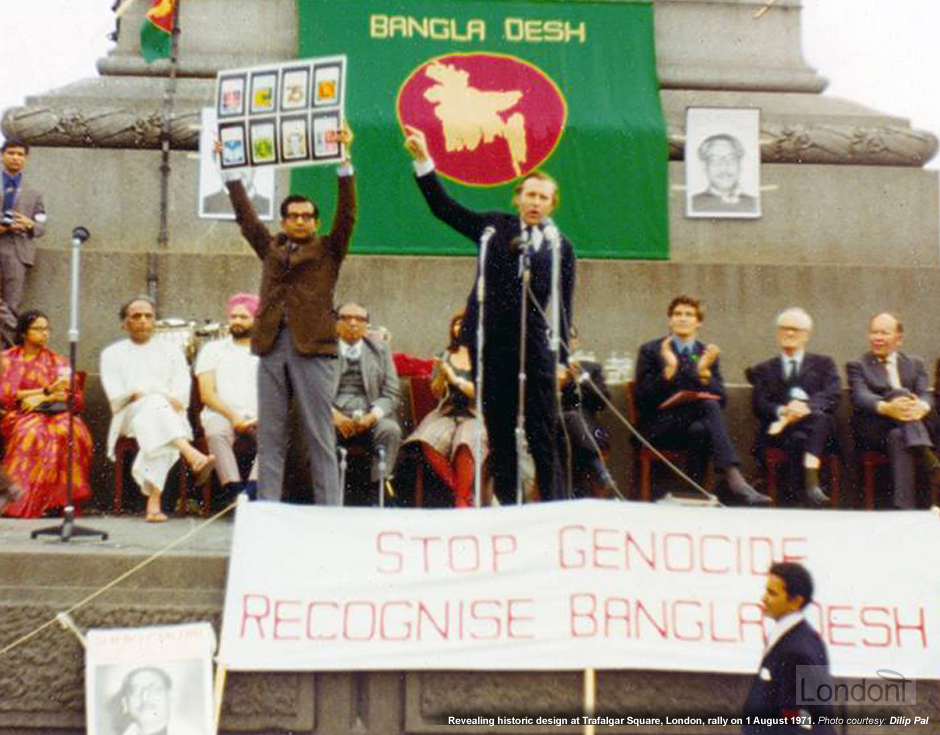
Few days after the stamps were officially published BimanChand Mullick attended the groundbreaking "Stop Genocide, Recognise Bangladesh" public rally held at Trafalgar Square in London, UK, on 1 August 1971. He sat on the stage along with his wife and other notables, including Justice Abu Sayeed Chowdhury. During his speech, John Stonehouse introduced BimanChand Mullick to the crowd and encouraged him to deliver a speech in Bangla. BimanChand Mullick stood next to John Stonehouse and held the a big poster of his 8 stamps above his head, sending the crowd into wild jubilation.
Stamps were released officially, thereafter there was a rally in Trafalgar Square. There were countless number of people there. Different newspapers estimate different figures as to the number of people that were there. Some say 20,000, others 40,000 and others 1 million. I don't know what the actual number was. All I know is that when I looked out from the top of the stage, it was an endless sight of the crowd. As far as the eye could see there was only human heads. John Stonehouse said to me "Speak to the people in Bangla and show them your stamps." So I showcased the rough design copy of my stamps by holding it above my head.
First stamps in independent Bangladesh
On 19 December 1971, three days after Bangladesh officially gained independence, John Stonehouse came to Dhaka in a special Army helicopter along with some senior officials of Bangladesh government. He brought with him a few hundred copies of the first eight-value stamps. He also brought with him three more stamps: 10p, Rs 5, and Rs 10 which had the words 'Bangladesh Liberated' overprinted in both Bangla and English in very small types. All the 11 stamps were put on sale at Dhaka GPO the very next day.
It was not until 30 April 1973 that a first regular set of postage stamps (14 in total were issued and circulated all over Bangladesh. These new stamps were denominated with taka (Tk) instead of rupees (Rs).
Major problems faced by the new government of Bangladesh in printing new postage stamps included the absence of own security printing press and proper technology, and shortage of appropriate material. Getting postage stamps printed from abroad was costly and time consuming. The quantity required was also huge. At the same time, there was a large stock of Pakistani stamps scattered all over the country in various treasuries and post offices. Due to lack of easy, prompt and proper transport and for security reason, the recall of these postage stamps from the post offices and overprinting those with a new name were not practical. But in the prevailing political environment and psychological reasons, it was undesirable to continue use of these stamps without making any change.
During the thirty years of postal history, from July 1971 to December 2001, Bangladesh issued as many as 784 different postage stamps. Until the commissioning of the security printing press of Bangladesh in December 1989, the Bangladesh Post Office had to get all its postage stamps printed from abroad (India, England, Australia, Spain, Austria and USSR). Designers and artists of both home and abroad have designed stamps of Bangladesh.
The original 8 stamps presented on a tray wrapped in golden cloth, is now preserved in the Muktijuddho Jadughar (Liberation War Museum) in Dhaka.
-
BimanChand Mullick had designed the first currency notes for Bangladesh after he was requested by John Stonehouse. On 24 December 1971, eight days after Bangladesh officially gained victory, The Statesman Calcutta newspaper published an article under the heading "Dacca plans new currency at par with rupee". A proud, young BimanChand in striped shirt and tie is photographed holding the design of the Tk. 1 and Tk. 10 which contain drawing of the Royal Bengal Tiger and Sheikh Mujibur Rahman respectively.
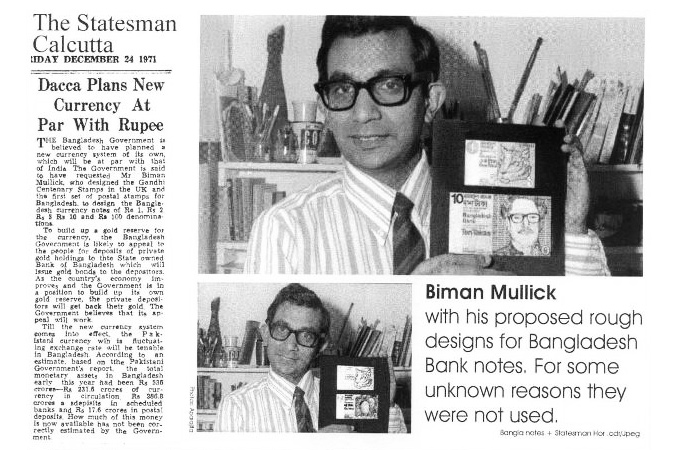
Source: BimanChand Mullick
Finally in 2012, 41 years after his historic contribution, the Government of Bangladesh recognised his contribution and conferred him a state award.
-
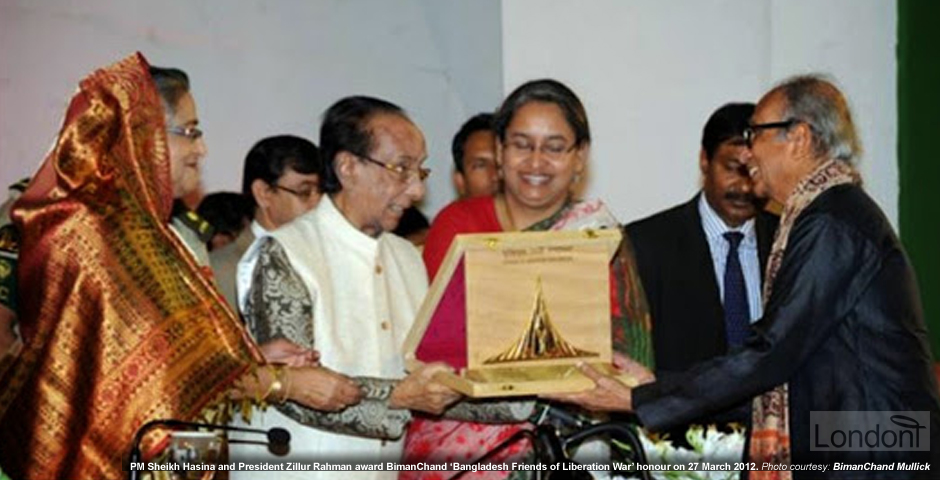
On 27 March 2012 - the day after Bangladesh's 41st anniversary - the Government of Bangladesh honoured 88 foreign individuals and institutions with the 'Friends of Liberation War Honour' title. Amongst the recipient was BimanChand Mullick.
Ujjal Das first person to alert BimanChand regarding award
On 5 September 2011 BimanChand was contacted by Ujjal Das, a journalist from Prothom Alo newspaper and later General Secretary of Treasure 1971 organisation. Ujjal found out about BimanChand while attending an event dedicated to Bangladesh Liberation War in East London. Both men met. Ujjal was only the second person from Bangladesh in 40 years to contact BimanChand regarding his contribution to Bangladesh Liberation War. The first person was Abdul Matin, a journalist, who contacted BimanChand around 1997.
Following their initial meeting, BimanChand did not hear from Ujjal for few months. Suddenly on 6 March 2012 Ujjal contacted him. He asked BimanChand if he had seen his email which he sent him. Attached to the email was a newspaper article where the Government of Bangladesh had announced that they were awarding the 'Friends of Liberation War Honour' to 129 recipients, including BimanChand. This was the first time BimanChand heard of such honour. (This news was related to the list of awardees, Second Phase. The list had only 88 recipients, not 129 as mistakenly, reported the news item.) The news made Biman, Aparajita and their daughter Sandra very happy.However, Sandra had pointed out, BimanChand Mullick had already won the ultimate award in 1971 by designing the first set of postage stamps for a new republic.
The prestigious state honour was handed out in seven phases and three different categories - Bangladesh Freedom Honour, Bangladesh Liberation War Honour, and Friends of Liberation War Honour. In the First Phase in July 2011, only Indra Gandhi, Indian Prime Minister during 1971, was the first 'foreign friend' to be conferred with the 'Bangladesh Freedom Honour', the highest honour. Her daughter-in-law and Congress party president Sonia Gandhi received the honour on her behalf at a special ceremony in Dhaka.
Travel to Bangladesh, for the first time
On 8 March 2012, two days after Ujjal Das alerted him about the award, BimanChand received an official invitation letter from Bangladesh Foreign Minister Dr. Dipu Moni on behalf of the Government of Bangladesh. He was invited to attend the prestigious state award in Dhaka on 27 March 2012. His flight from London would be 25 March 2012 and all expenses (flight, accommodation and other transportation) would be paid for by the Bangladesh Government. The letter was initially sent to the Bangladesh High Commission in UK who sent it to BimanChand Mullik.
On 25 March 2012 BimanChand travelled with Aparajita to London Heathrow Airport and was dropped-off by a family member. At the airport BimanChand met former Labour MP Michael Barnes who was also being honoured in the same award. Both men were the only surviving members from UK. There were also other representatives of awardees who had passed away.
Everyone was taken to the VIP lounge and flown to Dhaka with Bangladesh Biman, the Bangladesh's national airline. At Dhaka airport awardees were greeted by young volunteers and given a bouquet of roses. On the petal it said 'Welcome to Bangladesh', which left BimanChand and others astounded. The guests were then taken to the 'VVIP' lounge. VVIP refers to Very Very Important Person, and refers to VIPs with high rank or high esteem. Such treatment had melted BimanChand's heart. They were given an itinerary timetable for next 3 days. Sadly, for the British awardees no way could attend the morning events of the 1st day, because events finished before the arrival of the plane. Though the plane arrived on time. One of this was a river cruise in Buriganga nodi (river) which BimanChand was looking forward to do.
'Ruposhi Bangla'
BimanChand and few guests were taken to Ruposhi Bangla hotel, the 5-star former Sheraton Hotel of East Pakistan located next to Ramna Park in the heart of Dhaka. The hotel name conjured beautiful memories for BimanChand. Ruposhi Bangla means beautiful Bengal. Eminent Bengali poet Jibananda Das had written a collection of poems by the same name. These became so famous that Jibananda Das was popularly nicknamed "Ruposhi Banglar Kobi", the Poet of Beautiful Bengal. Jibananda was born in Barisal, Bangladesh, but settled in Kolkata where BimanChand was from.
When BimanChand arrived at the hotel a middle-aged couple came to Biman and called 'Biman-da', as if they knew him for a long time. 'Da' was shortened form for dada which means respected elder brother. This respect from two people that BimanChand was only meeting for the first time left him incredibly touched. The couple were Mr Sultan Shariff and his Irish wife Nora. The couple, also from London, had made gallant efforts to raise awareness of the Bangladesh Liberation War and help the muktijuddha (freedom fighters) during 1971. Nora Shariff was also being honoured with the state award. She had already arrived to Dhaka before BimanChand and others. Nora and Sultan had never met BimanChand before even though they lived in Forest Hill of South East London for all these decades.
First Day Cover (FDC) autograph
Later that day, BimanChand Mullick and guests were taken to Muktijuddho Jadughar, Liberation War Museum, then located at Segun Bagicha area of Dhaka (now in Agargaon area). But due to constant interviews from eager journalists, the guests were unable to view the content of the museum properly.
One of the many people who approached BimanChand was Siddique Mahmudur Rahman, a passionate philatelist from Bangladesh. Siddique and other Bengali philatelists, including Anowarul Quadir, met with BimanChand again back at the Ruposhi Bangla hotel around midnight. They then presented various version of First Day Cover (FDC) of BimanChand's 1971 stamps for him to sign. It had been a very long day and 78-year-old BimanChand was exhausted. He noticed some of the FDC were not the correct one. They were plagarised. However, the philatelists did not know this. They thought the FDCs were genuine. Not wanting to dishearten their passion and enthusiasm, BimanChand signed all of them.
Awards ceremony in Bangabandhu International Conference Centre
On 27 March 2012 BimanChand Mullick and other awardees and representatives from around the world were taken to Bangabandhu International Conference Centre in Dhaka where the Bangladesh Friends of Liberation War state award was being held.
Here, a Tapan Bagchi, Deputy Director at Bangla Academy, approached BimanChand and touched his feet as a sign of respect. Though this was normal custom within the Asian sub-continent, BimanChand felt slightly uncomfortable as he was not keen on this old practice. So out of humility, he too touched Tapan's feet, which startled the young man.
Not all 88 awardees or their representatives could not come to Dhaka and were not present at the ceremony. But the vast majority were.
My 3 days in Dhaka were just like a dream. I was deeply moved by meeting friends from the philatelic circle, friends from the fields of art and literature. I met so many like-minded people. I was completely overwhelmed. I never knew that there was so much love and affection waiting for me at Dhaka. I felt deeply moved by the generosity shown towards me.
When I first received the invitation from Dr. Dipu Moni the Foreign Minister I felt humbled, when I came to know the similar honour has been given to Mrs Indira Gandhi and I will be sharing the same honour with Mother Teresa.
I felt honoured. My family, especially my wife Aparajita and daughter Sandra equally shared my joy. My daughter commented, "To have the opportunity to design the first set of postage stamps for a country is a great honour. This invitation to receive an award for the stamps is an extra".
The 3 days in Dhaka were packed with programmes. It was too many good things in a very short period of time. I enjoyed participating in all programmes.
It was a moving experience to visit Liberation War Museum at Sengun Bagicha where we had opportunity to lay a wreath to those gave their lives for the country. Visiting "Shikha Chirontoni" at Suhrawardi Uddyan was an equally moving experience. It was an honour and a privilege to show my respect to the real heroes.
On Monday the 26 March 2012 we were taken to Martyrs' Memorial, Savar where we observed a Wreath Laying Ceremony at sunrise. Between these museum visits and attending ceremonies we had several lunches, dinners and receptions to attend where we had opportunity of tasting renowned "Dhakai" cuisine.
On Tuesday the 27 March 2012, naturally, the highlight of the day was to attend the award distribution ceremony, which took place in the morning at Bangabandhu International Conference Centre.
I became emotional just by listening to the citations of different awardees and their selfless contribution towards the liberation of Bangladesh.
I was highly impressed by observing the evidence of progress made by Bangladesh just in the short period of 40 years. But the greatest impression on my heart was left by the young generation of Bangladesh. I met some highly intelligent energetic youth. Meeting them.
I am very optimistic about the future of Bangladesh.
My thanks to all including members of Bangladesh High Commission staff, who silently worked behind the scenes and made my and other awardees stay in Dhaka a truly memorable experience.
BimanChand Mullick's letter to High Commission of Bangladesh recalling the three days he spent in Dhaka (from 25-28 March 2012) to receive his 'Friends of Bangladesh Liberation War Honour' [information received via email]
State dinners and security escort
During his three day stay in Dhaka, BimanChand Mullick and other nominees were invited to many dinner, including those given by Prime Minister and President of Bangladesh. They travelled around the city in mini vans accompanied by a doctor and casual-clothed detectives. Given that many of the awardees were now at a frail age, the Government of Bangladesh did not want to take any risk on their health and security. As such each mini van had a doctor and fellow security guards. Though this was a very thoughtful gesture, it did prevent the guest from speaking freely. Nevertheless, the Bengali officials and people treated BimanChand Mullick and guests with utmost respect and love.
BimanChand Mullick responded to the high praise in a way that is befitting of his humble nature.
"To develop the stamp for a nation is the biggest reward" - this is true. However, what is even more rewarding is to have the opportunity to create the stamps.
TV interview
The last official event was the Gala dinner hosted by the Prime Minister Sheikh Hasina in honour of the awardees in the evening on 27th March, where National dignitaries, ambassadors and other were invited. BimanChand was having dinner with a group when suddenly he was approached by a representative of a TV channel and requested him to come to their TV studio for an interview. BimanChand did not ignore the request. With the permission of his fellow guests, he left the table and followed the journalist to the studio where he gave an interview.
After the interview the channel staff gave him a paper to sign which included the fee for the interview. However, BimanChand told them to donate the fee to a charity. The TV crew informed him that they had a staff member who was in hospital and they will donate the money to them.
The next day, on 28 March 2012, BimanChand Mullick and guests were escorted back to Dhaka airport. While waiting in the lounge, BimanChand saw a brief clip of his interview from the previous evening being aired on the national channel.
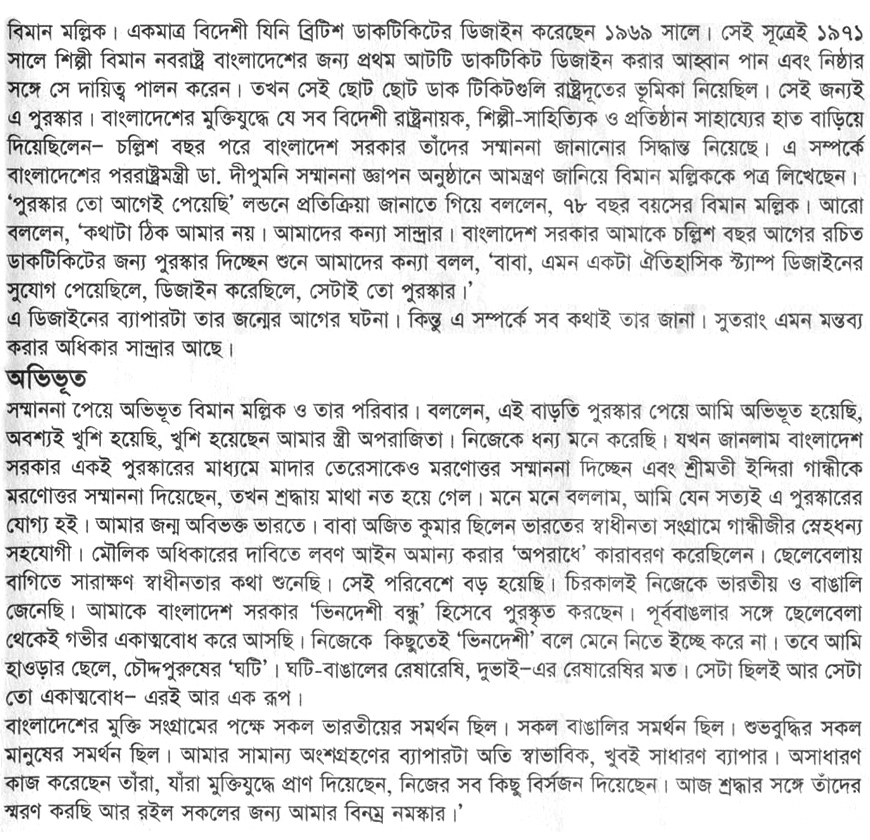
BimanChand Mullick tells journalist Abdul Matin his pride in receiving the state recognition [information received via email]
-
-
Few weeks after receiving the state honour, on 3 May 2012 BimanChand Mullick received "Friends of Bangladesh 1971" award from the Bangladesh citizens in UK.
The award was organised by Sultan Shariff on behalf of the Bengali community in Britain. The ceremony took place in London and was attended by Nora Shariff, Michael Barnes MP, and daughter of late Peter Shore MP, among others.
In order to achieve peace on earth, BimanChand Mullick believes that people should put humanity first and strive to love each other and do just act.
We cannot forget the past. But we can always forgive.
History is subjective. To get to the bottom of facts you need impartial perspective.
BimanChand Mullick believes we need to put the needs of the global community and search for truth before all else
-
In 1998 notable Bengali journalist and chronicler of Bangladesh's modern history Abdul Matin interviewed BimanChand Mullick and wrote an article based on the true accounts of the creation of the first stamps. Abdul Matin also made substantial other contribution in promoting this truth.
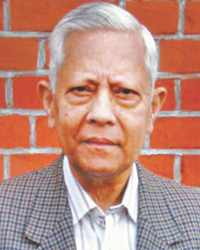 Abdul Matin (13 Apr 1924 - 12 Feb 2013) Award winning journalist, writer and political activist. Born in Noakhali. In 1971, actively participated in various movements and contributed to newspapers in UK to build support for Swadhinata Juddho. As a journalist he served United Press of India, Daily Azad, Daily Sangbad, United Press of Pakistan and Pakistan Observer, among others. Wrote many books on Bangabandhu, the Liberation War and other topics, including "Geneva-e Bangbandhu", "Shwadhinota Shongram-e Probashi Bangali", "Probashir Drishti-te Bangladesh", "Shamsuddin Abul Kalam O Tar Patraboli", "Bangabandhu Sheikh Mujib: Koyekti Prashongik Bishoy", "Jibonsmriti: Ekti Bishesh Odhyaye", "Bangabandhu Sheikh Mujib: Muktijuddher Por", "Di-Jaati Totyer Bishbrikkho", "Europe-er Deshe Deshe", "Voltaire: Ekti Ananya Jibon Kahini and Kaste (short stories)". Received Swadhinata Purushkar (Independence Day Award) in 2009. Died due to old-age complications in a London hospital. Left behind wife and a daughter.
Abdul Matin (13 Apr 1924 - 12 Feb 2013) Award winning journalist, writer and political activist. Born in Noakhali. In 1971, actively participated in various movements and contributed to newspapers in UK to build support for Swadhinata Juddho. As a journalist he served United Press of India, Daily Azad, Daily Sangbad, United Press of Pakistan and Pakistan Observer, among others. Wrote many books on Bangabandhu, the Liberation War and other topics, including "Geneva-e Bangbandhu", "Shwadhinota Shongram-e Probashi Bangali", "Probashir Drishti-te Bangladesh", "Shamsuddin Abul Kalam O Tar Patraboli", "Bangabandhu Sheikh Mujib: Koyekti Prashongik Bishoy", "Jibonsmriti: Ekti Bishesh Odhyaye", "Bangabandhu Sheikh Mujib: Muktijuddher Por", "Di-Jaati Totyer Bishbrikkho", "Europe-er Deshe Deshe", "Voltaire: Ekti Ananya Jibon Kahini and Kaste (short stories)". Received Swadhinata Purushkar (Independence Day Award) in 2009. Died due to old-age complications in a London hospital. Left behind wife and a daughter.
When Abdul Matin sadly passed away on 12 February 2013 at the tender age of 88, Biman Mullick wrote an article recalling their encounter and praising Abdul Matin for his vast contribution in chronicling Bangladesh's history. Other fellow journalists also praised Abdul Matin for his dedication.
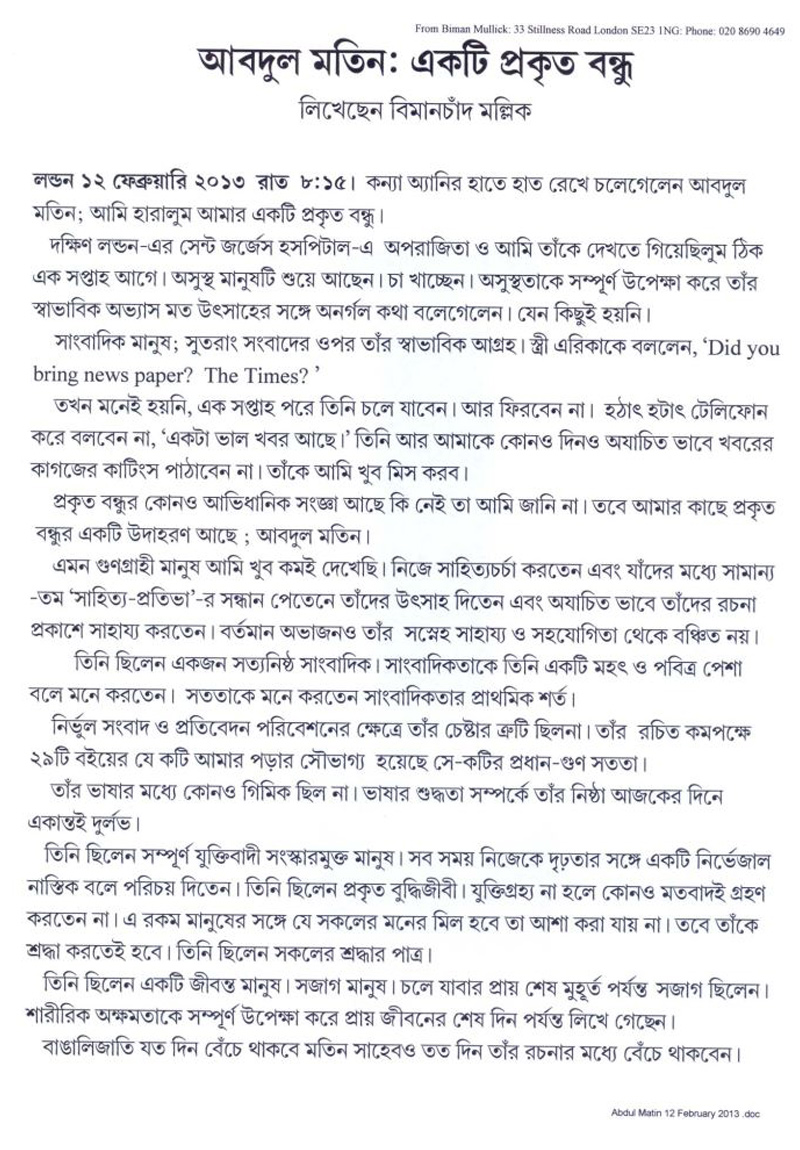
BimanChand Mullick on what made journalist Abdul Matin special
He [Abdul Matin] was constantly bubbling over with ideas and often called me in Dhaka from his home in south-west London, a city where he had been settled since 1960. He loved conversation; and if it was about politics, his enthusiasm was palpable and without end. On the phone he would often speak to me of some old newspaper article he had fished out from his collection and of a photocopy of which he was mailing me. And when his new books were published in Dhaka, he wrote to his publisher and to Sanchita, my friend and one who has held Matin Bhai in deep reverence, to have a copy delivered to me. On the phone, as he neared the end of the conversation, he would let me know that he did not have much of life remaining in him and therefore wanted to pass on to me his perspective on Bangladesh’s history. I tried to remonstrate with him over his feeling of creeping mortality, but he would gently brush my protests away.
Matin Bhai and I have talked long and deep over the way in which Bangladesh’s history took a nosedive after August 1975. He loved Bangabandhu without reservation; and he was truly glad that my appreciation of Bangabandhu was something that approximated his.
Abdul Matin was a Bengali nationalist in every sense of the meaning. Despite the fact that he was away from the country, his soul always remained in Bangladesh. In 1971, he played a paramount role in popularizing the Bangladesh cause in Britain. His chronicling of Bangladesh’s history effectively began through his account of Bangabandhu’s presence in Geneva for medical treatment in 1972. In the following years and decades, Matin Bhai wrote prolifically on politics and history in clear, unambiguous terms. He was a man of strong opinions and brooked no nonsense about Bangladesh's background from anyone and especially Bengali journalists who were his contemporaries. Two years ago, he gave me a copy of a news item published in London’s Times newspaper in June 1971. It was a dispatch from one of his friends, today a well-known elderly journalist, informing readers that conditions were returning to normalcy in East Pakistan. In the year or two before his death, he was deeply upset with another friend, who too is a journalist, who he believed had been very economical with the truth in his presentation of realities about Bangladesh’s politics. He once told me how Enayetullah Khan, the late founder-editor of Holiday, our Mintu Bhai, had threatened to sue him over something he had written. Matin Bhai sought his lawyer's advice and waited for the lawsuit to be served on him. Eventually, however, matters cooled down.
Matin Bhai was thrilled that I was writing a biography of Bangabandhu Sheikh Mujibur Rahman in English and happily gave me some valuable ideas on how to go about doing it. In our conversations, he enlightened me on matters he had not written about but made it clear that after he was gone, I should be raising them in my writing. I gave him my word I would keep his faith in me.
Abdul Matin - my friend, my teacher, my mentor - has gone the way of all flesh. He joins all those illustrious men from whom I learned and who have passed on - Shawkat Osman, Waheedul Haque, Syed Najmuddin Hashim and Garib Nawaz Khan. The skies change colour. The clouds turn darker.
Journalist Syed Badrul Ahsan's remembers his close friend Abdul Matin
-
29th July is 'Daktikit Dibosh'
In Bangladesh 29th July is celebrated as 'Daktikit Dibosh' (Stamps Day) in recognition of the publication of the first postage stamps of Bangladesh created by BimanChand Mullick on 29 July 1971.
The first set of postage stamps for Bangladesh was issued on 29 July 1971, which not only created worldwide attention but also left an indelible mark on the history of philately.
One day unexpectedly I received a letter from Satyajit Ray. I admired him from a distance. I was inspired by his work but never had the opportunity to know him or to meet him. In his letter, with reference to Bangladesh stamps he complemented me and invited me to see him on my next visit to Kolkata. I was deeply moved and felt truly honoured. It took me a few years to pay him a visit.
I went to see him on 6 January 1976. Aparajita, our 4-year-old daughter Sandra, one of my elder brothers Rabindranath and my nephew Fagun accompanied me.
In our meeting we did not discuss films. I talked about his interest in typography and type design with special reference to 'Ray Roman'. But he talked about the British issue of the Gandhi Centenary Stamp of 1969 and the first set of stamps for Bangladesh. Suddenly, form his vast collection of books he brought a copy of "Myths and Legends of India" published in 1970 which contained around 150 colour drawings by me. I was totally surprised. I felt honoured and humbled by knowing that he was aware of my work. During our meeting Fagun took some photographs.
BimanChand Mullick recalls his first meeting with the legendary film director Satyajit Ray
"Shokher Raja Daktikit Shangroho" book and "Attoprokash Stamps '71" documentary
In 2011 General Secretary of Philatelist Association of Bangladesh (PAB), A. T. M. Anowarul Haque Quadir, wrote the book "Shokher Raja Daktikit Shangroho" (Stamp Collecting - the king of hobbies) where he speaks about how BimanChand Mullick designed the first stamps of Bangladesh.
In 2013 M. A. Saif Mahabub produced and directed a short documentary on the first set of postage stamps of Bangladesh. Entitled "Attoprokash Stamps '71" the 20-minute long documentary features an extensive interview BimanChand Mullick who gives in-depth insight on the days leading to the creation of the stamps. Others who also appear in the documentary are A. T. M. Anowarul Haque Quadir, Salam and Murtaja Basser.
Both "Shokher Raja Daktikit Shangroho" and "Attoprokash Stamps '71" have been highly praised by BimanChand Mullick himself for their authenticity.
Dear Saif, Thank you, thank you, thank you. I think it is a great, great, great film. Congratulations! Congratulations! Congratulations! My thanks to all who worked behind the film. Best wishes. Onek onek shubhechh-chha [Thanks a lot!].
BimanChand Mullick ecstatic after watching "Attoprakash stamps '71"
 A. T. M. Anowarul Haque Quadir (Born 29 May 1960)
A. T. M. Anowarul Haque Quadir (Born 29 May 1960) 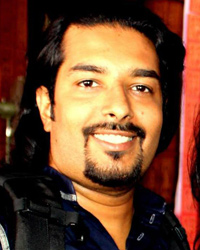 M. A. Saif Mahabub ()
M. A. Saif Mahabub ()
-
-
Storyteller, poet, social activist and 72-year-old marathon runner
In addition to his great contribution to the history of Bangladesh, BimanChand Mullick has also actively participated in other social and educational activities. He is the Honourable Director for Cleanair, a non-profit organisation he founded in 1972 to promote smoke-free environment. In 1988 the World Health Organization (WHO) awarded him an honour in recognition of his contribution towards creating a pollution-free world. The same honour was bestowed upon former US president Jimmy Carter and President Fidel Castro at the same time for the same reason. BimanChand Mullick also designed posters for World Health Organization's (WHO) 'Framework Convention on Tobacco Control' (FCTC) convention held in Geneva, Switzerland on 12-13 October 2000.
A passionate storyteller and poet, BimanChand Mullick has also designed the pictures for the children story 'Hanuman Saves the Prince' which featured in a BBC 2's children programme in UK. In 2006 BimanChand Mullick also completed the famous 26.2 miles (41.195 km) long London marathon at the tender age of 72 after being pushed to jog by his wife Aparajita Mullick who bought him a jogging suit for his 50th birthday, to his horror.
But above all, BimanChand Mullick is a proud Bengali. His career is full of examples of how he has actively participated to spread the Bengali culture not only within the Bengali community but also globally to the wider audience. His participation in the University of London's "Bengali for non-Bengalis" programme, and production of picture books for children who are growing in non-Bengali environment are two examples of such gallant efforts.
5% of the Bengali speaking population lives outside Bengal (Geographically speaking). So far as I know, there is no book for children to introduce Bengali through English medium. I personally found the need for a long time. In recent years, to introduce Bengali to my grandchildren, I created this book called "My 1st Book of Bengali". I tried not only with my grandchildren but also with other English-speaking children and I received very positive responses.
Though this book is for children I think the adult learners would find it useful. I am looking for a publisher.
This idea can be adapted to introduce other languages such as Hindi, Gujarati and Punjabi etc.
BimanChand Mullick's efforts to spread Bangla via his book "My 1st Book of Bengali" [information received via email]
-
-
Coming soon
-
